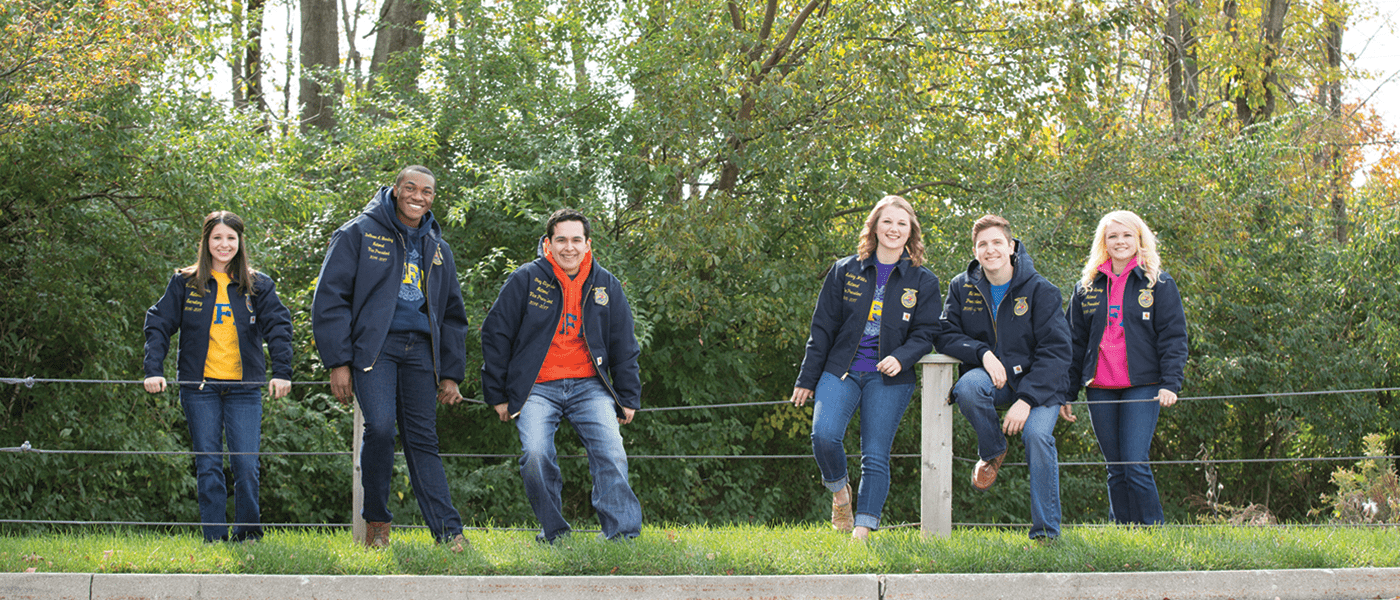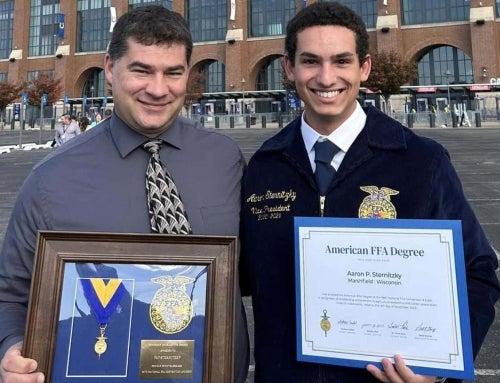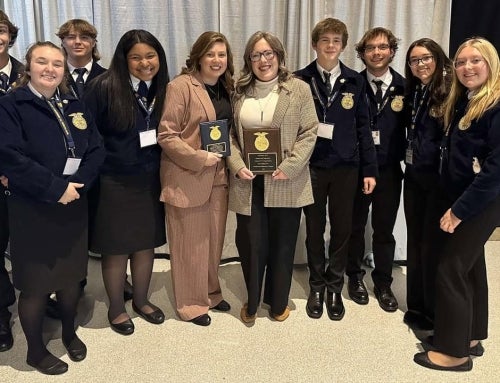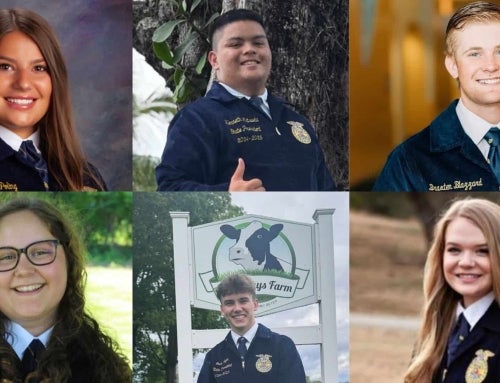Ride along with the National FFA Officers as they travel to all corners of the country to strengthen the organization.
[dropcap size=small]A[/dropcap]fter months of mind-numbing prep typically reserved for the likes of Fortune 500 executives, that’s how long it takes to transform the lives of six FFA members. Thousands of attendees wait in suspense during each National FFA Convention & Expo. Then confetti rains down on the arena stage, and six FFA members are named National FFA Officers. They turn into blue-jacketed rock stars and begin a transformational journey that started the same as all FFA members — by reciting the FFA Creed as Greenhands in an ag classroom.
Even with those humble beginnings, members-turned-national officers ooze a confidence that makes them natural-born leaders committed to the growth of the organization. It’s an 89-year-long tradition that began when New Jersey’s Leslie Applegate led the first national officer team in 1928.
“I’m super excited to be able to give my time to serve an organization that has given so much to me and to so many other members in the FFA,” says David Townsend. Townsend is the first FFA member from Delaware to become national president and joins National FFA Secretary Victoria Harris, Eastern Region Vice President Ashley Willits, Central Region Vice President Valerie Earley, Southern Region Vice President DeShawn Blanding and Western Region Vice President Trey Elizondo, who comprise the 2016-17 National FFA Officer team.
A Year of Service
During their term, the national officers will log more than 100,000 miles of travel each (including a nearly two-week-long trip to Japan to study international agricultural trade and to meet with government and agriculture officials) to represent FFA and agricultural education. On average, each national officer visits 25 states or more and will wear at least six FFA jackets over the course of the year (blue corduroy fades fast when worn every day). Travel agendas include speeches, leadership conferences, chapter banquets, state conventions, meetings and workshops prepared for the 649,355 FFA members they will meet. The officers also speak to members via Facebook, Instagram and Twitter during a minute-long, monthly video podcast that features topics important to the officers.
They receive college scholarships and travel expenses from the organization, but the experiences the job offers provide deep meaning.
“I’m looking forward to getting to know the members,” Blanding says. “I remember when I was that freshman and so shy and timid. But because someone devoted time to me and pulled me out of my comfort zone, I was able to grow and flourish as a leader. I’m looking forward to doing the same for FFA members across the nation.”
The journey of a national officer is finely orchestrated by a team of FFA staff led by Coty Back, who was also a national officer in 2006. “We want the national officers to understand this isn’t a year of discovering what they can get out of this opportunity,” says Back. “Rather, it is a year of them pouring into others and serving the organization as a whole. If they can say or do something that helps even one member become a better person or leader, their year will have been worth it.”
The educational and corporate leaders the team gets to rub shoulders with also make the experience worth it. National FFA Foundation partnership visits allow the officers to get an overview of a company and its industry (from Tyson Foods and John Deere to Domino’s Pizza and Ford Trucks), learn about the challenges that industry faces and discover how the company is meeting those challenges. College students themselves, the officers can also receive career advice from company representatives. In turn, the officers explain the challenges FFA faces, answer questions from company representatives about FFA and agricultural education, and personally thank those who support FFA. The officers can take what they learn from these visits and communicate the messages to FFA members.
Enrich the FFA Experience
The national officers also sit on the National FFA Board of Directors. They help set policies that will guide the future of the organization and promote agricultural literacy. Arguably, the most important facet of the national officer team’s year is its legacy project. Legacies vary for each national officer team and have covered topics ranging from the agricultural educator shortfall to using the three-component model to #SpeakAg. Regardless of the topic, the goal is to enrich the FFA experience for generations to come.
“It really comes down to one question. How are you going to make whatever you are leading — chapter, organization, community, group of people, etc. — better because of the work you did?” Back asks. “It is important for us, as leaders, to have a vision and an idea of how things can be improved. Our national officers are the student voice. Like all leaders, they must envision what the ‘better’ will look like in the future and help make it so. This is how leaders can leave a legacy.”
Each January, the officers and Back travel to Soderquist Leadership in Siloam Springs, Ark., for legacy brainstorming and development. They work on individual and team values, then Back explains the organization’s strategic plan and values. The team then comes up with a way to contribute to the long-term plan of FFA.
Active Alumni
The 2015-16 National Officer Legacy Project tackled the misconception that taking off the blue jacket after high school graduation ends a member’s commitment to growing leaders, strengthening agriculture and building communities.
“Soon after being elected as national officers, our team was challenged to find our place in helping FFA achieve its strategic plan of engaging our students, supporting our advisors and telling our story,” 2015-16 National FFA President Taylor McNeel says. “When we sat down to brainstorm our legacy platform, alumni came up because they support all parts of the strategic plan.”
At the time, the National FFA Alumni Association enjoyed an active roster of 60,000 members. But with about 80,000 FFA members going their separate ways after high school annually, the organization and national officers saw an opportunity for growth. They moved to make all graduating high school seniors associate alumni members for five years. “If current FFA members learn about alumni and see how they can be involved, they will become engaged after graduation,” McNeel adds.
Unfortunately, less than a third of all FFA chapters have an active alumni chapter, and many FFA members and communities have not seen the impact of an organized alumni group. That’s not the case for the Dassel Cokato FFA Chapter in Minnesota. The 2015-16 officer team visited this one-teacher program that touts more than 200 FFA members and even more agricultural education students. While this chapter is one of the most active and successful in the state, effective alumni make it possible. Teacher Erik Swatzke can focus on the classroom while his alumni members coach everything from livestock judging teams to parliamentary procedure. They also help fill out scholarship applications and prep for chapter officer elections.
“Mr. Swatzke told me, ‘Without my alumni, I’d have an 80-hour workweek. The alumni make my job so much easier and their support is invaluable.’ This is a prime example of just how unrestricted and appreciated the work of the alumni can be,” says 2015-16 National FFA Secretary Nick Baker.
So the team created goals and an action plan to promote, recruit and retain engaged FFA alumni members.
The plan paid off. The National FFA Alumni Association typically sees a yearly membership growth of around 8 percent. After word of the legacy platform spread on social media and during the Alumni Development Conferences, 204 new alumni chapters were chartered. Along with the help of a new partnership with Alpha Gamma Rho alumni and the activation of graduating seniors’ alumni membership, FFA Alumni membership swelled by nearly 300 percent to more than 225,000. The campaign also featured a grant from Tractor Supply Company that awarded $500 each to four new and four existing alumni chapters.
Whether through their retiring addresses or a casual conversation with an FFA member sitting in the back of the room, the national officers inspire thousands with their work for FFA.
“I have seen members walk out of workshops with new ideas on how to better serve their communities or their friends,” Back says. “I have seen members feel valued because an officer heard them crying alone in a bathroom and asked them if they were OK. I have received phone calls from advisors because a conversation an officer had with their administrators led to a tenfold increase in funding for their agricultural education department. Officers have been able to mobilize thousands of students to share their voice and to speak out about the impact of agricultural education and FFA.”
Katy Mumaw contributed to this story.












